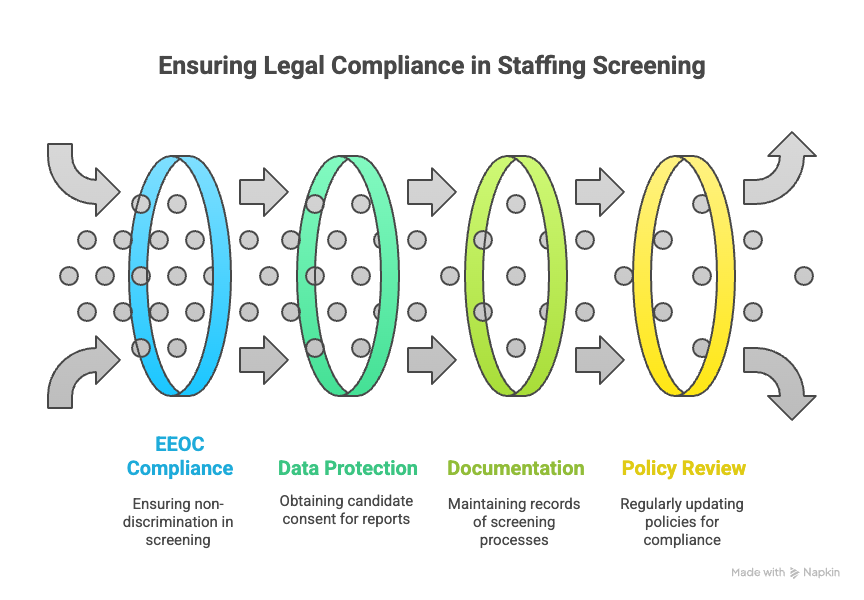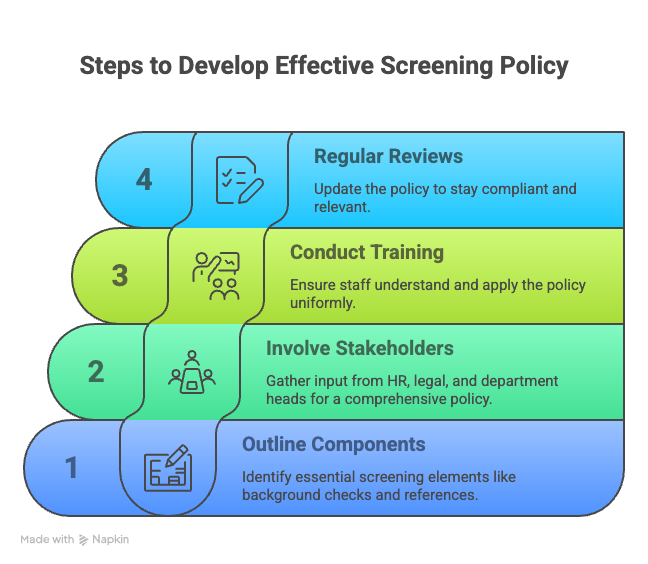Creating a robust staffing screening policy isn't just good business; it's essential to mitigate risks and ensure a productive, legally compliant workforce. Whether you're a small business looking to formalize your hiring process or a large corporation seeking to update your practices, this guide will provide you with the foundation to build a comprehensive staffing screening policy. We'll explore the core components, legal considerations, and best practices, ensuring your hiring decisions are informed and compliant.
Key Takeaways
- Implementing a staffing screening policy protects your company's reputation and resources by ensuring only qualified candidates are hired.
- The policy should include tailored background checks, reference verifications, and role-specific screenings to minimize hiring risks.
- Compliance with legal guidelines, such as the EEOC and FCRA, is crucial to avoid discrimination and protect candidate data.
- Developing the policy involves collaboration with HR, legal, and department heads, ensuring it's comprehensive and aligned with organizational needs.
- Regularly review and update your policy to stay compliant with changing laws and industry standards, maintaining an effective and responsible hiring process.
EXPERT INSIGHT: Over time, I've seen the immense difference a clear staffing screening policy can make—not just for compliance, but for culture itself. It is never about protection of the business alone; it is about protecting the people we depend upon to create a safe and fair workplace. A thoughtful policy gives candidates confidence that they are being evaluated with consistency and respect, while at the same time giving hiring groups the specificity needed to make a clear decision. Done well, screening moves beyond mere barriers; it is a tool for building an anchor based upon trust, safety, and long-term success. - Charm Paz, CHRP
Introduction
A well-structured staffing screening policy is more than a checkbox exercise; it safeguards your company's reputation and resources. A comprehensive policy helps identify the right talent while minimizing risk. But what exactly does this policy entail, and why should you care?
Think of a staffing screening policy as your blueprint for hiring success. It defines how you assess candidates' qualifications and fit, encompassing background checks, reference verifications, and role-specific screenings. By following a clear policy, you ensure that you're making informed hiring decisions.
This guide takes you through building an effective staffing screening policy. We'll focus on legal compliance, risk management, and tailoring requirements for specific roles. Let's explore how you can implement strategies that not only protect your organization but enhance its productivity and culture.
A staffing screening policy outlines the methods and procedures used to evaluate potential employees before hiring. This policy ensures that only qualified, trustworthy candidates join your organization. It's a critical step in protecting business interests.
The main objectives of a staffing screening policy are to filter candidates effectively and reduce the risk of negligent hiring. By establishing specific criteria, you can systematically assess applicants' skills, qualifications, and character. Consider how this helps maintain your company’s standards while avoiding legal complications.
The importance of this policy can't be overstated. It acts as a first line of defense against negligent hiring, which can lead to costly legal battles and harm your business's reputation. Not only does it enhance workplace safety, but it also improves the quality of your employees. Organizations with solid screening policies often see higher productivity and morale.
Have you thought about how a staffing screening policy can shape your company's culture and success? Reflect on your current approach and identify areas for enhancement. As you consider these points, remember that each hire can significantly impact your organization’s future.
Core Components of a Staffing Screening Policy
A well-defined staffing screening policy is vital for a secure and efficient hiring process. It requires attention to a range of elements, each serving a specific purpose. Here are some key components you should integrate into your policy:
Role-Specific Background Checks:
It's crucial to understand that not all roles require the same level of background scrutiny. Different positions come with varying responsibilities and risks. For instance, a financial role might necessitate a credit check, while a position involving vulnerable populations could require a more thorough criminal history examination. Tailor your background checks according to the job’s responsibilities to ensure you're assessing candidates appropriately without overstepping legal boundaries.
Negligent Hiring Prevention:
Negligent hiring can cost your company both financially and reputationally. It involves holding employers liable if an employee causes harm and it becomes evident that a proper background check wasn't conducted. Implement exhaustive vetting procedures, including thorough checks on criminal history and employment verification, to mitigate this risk. These steps help affirm that you are making well-informed hiring decisions.
Ban-the-Box Compliance:
The "Ban-the-Box" initiative aims to eliminate barriers to employment for individuals with criminal records by removing the conviction history question from job applications. Understand your local laws regarding this mandate and adjust your application procedures accordingly. This compliance not only aids social mobility but also broadens your candidate pool.
Reference Checks:
Verifying past employment and character references remains an integral part of the screening process. Reach out to previous employers and colleagues to gain insights into a candidate's work ethic and performance. Ensure your questions are structured to elicit relevant information that aids in confirming the applicant’s suitability for the role.
Drug Testing:
Drug testing can be a pillar in safeguarding workplace safety and productivity. Ensure you're aware of the legal regulations governing drug testing in your state or industry. Implement a consistent policy, detailing when and how testing will occur, to avoid misunderstandings or legal issues.
These components form the backbone of a comprehensive staffing screening policy. They've been honed through years of industry experience. By focusing on these core elements, you'll create a policy that safeguards your organization from potential pitfalls while fostering a strong and competent workforce. Remember, each component should align with not just legal obligations, but also with your organization’s values and needs.
Legal Considerations
Understanding the legal landscape of staffing screening is crucial for avoiding costly mistakes. First, familiarize yourself with key federal guidelines, like those from the Equal Employment Opportunity Commission (EEOC). These guidelines help ensure your screening practices don't discriminate based on race, color, national origin, sex, religion, disability, or age.
Data protection is another critical area. Laws such as the Fair Credit Reporting Act (FCRA) set clear rules for obtaining consumer reports, like credit and background checks. You'll need the candidate's written permission before proceeding. Failing to comply can lead to serious penalties.
Proper documentation can be your best defense against legal challenges. Keep records of all background checks, noted decisions, and candidate consents. These documents can protect your organization if disputes arise about hiring decisions.

Do your current practices align with these legal standards? Regularly review your policies to ensure they do. Compliance is an ongoing process, not a one-time event. Staying informed about changes in laws is essential for maintaining a legal and ethical hiring process.
Developing Your Policy
When you're ready to draft your staffing screening policy, clear and concise writing is critical. Start by outlining the essential components, including background checks, reference verification, and any role-specific screenings you plan to implement. Each section should have a straightforward explanation of why it's necessary and how it will be conducted.
Involve stakeholders from the start. Gather input from HR professionals, legal advisors, and department heads. Their insights can help tailor the policy to meet both legal standards and organizational needs. A collaborative approach ensures the policy is comprehensive and practical.
Training is the next step. Your team should understand the policy inside and out. Training sessions can help staff apply the policy uniformly, which is vital for consistency and fairness. Address potential biases head-on. Discuss them openly and set clear guidelines to avoid them.
Regular reviews are a must. Laws and industry standards change frequently. Set up a schedule to review and update the policy. This keeps your screening process compliant and relevant. Encourage feedback from hiring managers and candidates. They can provide practical insights into how well the policy works in real-world scenarios.

Engaging with this process ensures your staffing screening policy stays effective and up-to-date, creating a solid foundation for your hiring practices.
Conclusion
A comprehensive staffing screening policy is indispensable for any business committed to responsible and informed hiring. This guide has laid out the structure necessary for creating such a policy, underscoring legal compliance, risk management, and role-specific requirements. Now, take action: revisiting your current processes is essential. Evaluate what's working, identify gaps, and refine your approaches for a policy that not only protects your organization but also embraces a skilled, diverse talent pool. By maintaining a vigilant, adaptable screening strategy, you safeguard your company’s future and reputation. Further, you show candidates and employees that transparency, fairness, and safety are not policies but commitments your work culture lives by. Every screening decision is no longer a piece of formalism; it is an expression of values and integrity shaping your culture. With passage of time, consistency not merely reduces risk but builds lasting trust and reinforces your reputation as an employer whom people are pleased to work with.
Frequently Asked Questions (FAQs)
What should a staffing screening policy include?
A staffing screening policy should outline the criteria for evaluating candidates. It should detail the types of background checks conducted, such as criminal history, employment verification, and education checks. The policy must specify the procedures for handling sensitive information and address legal compliance. Including guidelines for disqualifications and an appeals process can also be beneficial.
How to ensure FCRA compliance in screening policies?
To ensure compliance with the Fair Credit Reporting Act (FCRA), you should inform candidates in writing that background checks will be conducted. Obtain their written consent before proceeding. If adverse action is taken based on the report, provide candidates with a copy of the report and a summary of their rights. Regularly review FCRA guidelines to stay updated with changes.
What are the consequences of not having a screening policy?
Without a screening policy, staffing agencies risk hiring unsuitable candidates, leading to potential legal liabilities and reputational harm. The lack of a standardized process can result in inconsistent hiring practices and possibly a higher turnover rate.
How often should staffing agencies update screening policies?
Staffing agencies should review and update screening policies at least annually. This ensures compliance with any new laws and reflects changes in industry standards or organizational needs. Regular updates help maintain the effectiveness and relevancy of the screening process.
What background checks are essential for staffing agencies?
Essential background checks include criminal history, credit reports (for roles involving financial responsibilities), employment verification, education verification, and reference checks. These checks help ensure candidates meet the necessary qualifications and have no disqualifying factors.
How can staffing agencies handle data privacy in background checks?
Respect candidates' privacy by securing and limiting access to their personal data. Follow data protection laws and clear records after a specific period in compliance with legal requirements. Inform candidates about data handling practices.
What should a staffing agency do if a candidate disputes a background check finding?
If a candidate disputes a finding, re-evaluate the information and conduct further verification if needed. Allow the candidate to provide any supporting documentation or context to address discrepancies.
How can staffing agencies improve candidate experience during screening?
To improve candidate experience, keep communication clear and transparent. Inform candidates about each step of the process and expected timelines. Provide contact information for any questions or concerns they may have.
What role does technology play in staffing screening policies?
Technology can streamline screening processes by automating background checks and maintaining organized records. It can also enhance accuracy and efficiency, reducing human error and ensuring a smoother experience for candidates.
Definitions
Staffing Screening Policy
A staffing screening policy is a company’s written procedure for evaluating job candidates before hiring. It outlines specific checks, such as background verification, drug testing, and reference calls. The goal is to hire qualified individuals and lower the risk of bad hires. A clear, consistent policy also helps you align with legal standards and ensure fair treatment during the hiring process.
Negligent Hiring
Negligent hiring occurs when a company fails to properly vet a job candidate and that employee later causes harm. If it’s proven that reasonable steps like background checks were skipped, the employer may be held legally responsible. Preventing negligent hiring requires documentation and consistency in applying screening procedures.
Background Checks
Background checks gather information on a candidate’s history, such as criminal records, credit reports, and employment history. These checks help you confirm the accuracy of a resume and assess potential risks. Tailor each check to the role—financial positions may need credit reports, while childcare roles may require more extensive criminal screenings.
Ban-the-Box Compliance
Ban-the-box laws require employers to remove criminal history questions from initial job applications. The idea is to give people with past convictions a fair chance to compete for jobs. You still can conduct criminal background checks, but only later in the hiring process. Always check your local and state laws to stay compliant.
Reference Checks
Reference checks involve contacting former supervisors or colleagues to gather insights about a candidate’s past job performance and behavior. Ask focused, job-related questions—like how the candidate handled deadlines, conflict, or team collaboration. This step adds depth to your evaluation and can confirm or challenge what’s in a resume or interview.
References
- Quantitative and Qualitative Staff Mismatch in Healthcare: https://pmc.ncbi.nlm.nih.gov/articles/PMC11471616/
- Employment Screening Best Practices: https://fadv.com/white-paper/employment-screening-best-practices/
- Best Practices in Vetting Prospective and Current Employees: https://www.dhs.gov/sites/default/files/publications/phase_ii_-_best_practices_in_vetting_prospective_and_current_employees.pdf
Still have questions?
Get in touch with our team today for a personalized demo and discover how our tailored volume pricing and packages can drive results for your business!
How useful was this page?*
Note: your comments are anonymous. We use them to improve the website. Do not include any personal details.
Visit our FCRA Compliance Tool or leave a message here if you need a response.
From the blog Explore the GCheck Content Hub

FACIS Background Check: 2026 Healthcare Compliance Guide
18 Dec, 2025 • 20 min read
Food Delivery Driver Background Check: Complete Compliance Guide for Restaurant Operators
17 Dec, 2025 • 17 min read
Texas Education Background Checks: 2026 TEA Compliance Guide for Schools & Districts
17 Dec, 2025 • 23 min readThe information provided in this article is for general informational and educational purposes only and should not be construed as legal advice or a substitute for consultation with qualified legal counsel. While we strive to ensure accuracy, employment screening laws and regulations—including but not limited to the Fair Credit Reporting Act (FCRA), Equal Employment Opportunity Commission (EEOC) guidelines, state and local ban-the-box laws, industry-specific requirements, and other applicable federal, state, and local statutes—are subject to frequent changes, varying interpretations, and jurisdiction-specific applications that may affect their implementation in your organization. Employers and screening decision-makers are solely responsible for ensuring their background check policies, procedures, and practices comply with all applicable laws and regulations relevant to their specific industry, location, and circumstances. We strongly recommend consulting with qualified employment law attorneys and compliance professionals before making hiring, tenant screening, or other decisions based on background check information.


